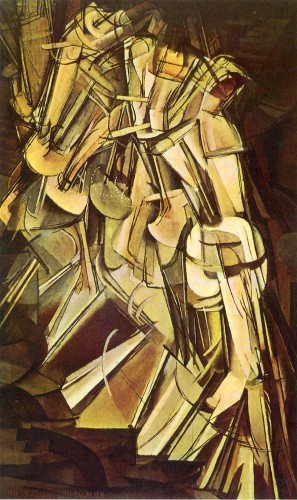Marcel Duchamp i(1887-1965) is well known in America. Most people have heard of his readymades like the famous (or infamous) Fontaine, which is, in fact, a public urinal. Stiglitz immortilized the original in a 1917 photograph before it disappeared for ever. The bicycle wheel set on a kitchen stool is a familiar sight for MOMA vistors.

Since his first trip to the US in 1915, the artist made multiple visits to that country, avoiding the two World Wars. He acquired American nationality in 1955. It was at the 1913 Armory Show that his cubist painting ‘Nu Descendant un escalier No. 2′ (Nude going down a staircase No. 2) became a huge success.
Some critics have labelled Marcel Duchamp as the creator of modern art while others say he destroyed it when he advocated “non-retinal” painting. Volumes have been written about him. In an amazingly short time – since he abandoned art for chess at age 36 – he was able not only to produce art, but also to integrate into it the latest discoveries of science and modern technology.
The Marcel Duchamp exhibit at the Pompidou Center just closed its doors after several successful months. It was a monographic approach consisting of about 100 paintings and drawings little known in France (most of them are part of the Louise and Walter Arensberg collection at the Philadelphia Museum of Art) covering the 1912 to 1923 period and leading to his main creation, ‘Le Grand Verre.’
Born in Normandy, Duchamp belonged to a talented family of six children. The mother was a distant figure, which may explain his alienation from women. ‘Sonate,’ 1911, represents the three sisters playing musical instruments. The mother stands stern and erect . Strangely enough she seems to be enjoying the concert, although she is deaf.
He had a deadpan sort of humor and provocation was his tool. He enjoyed playing tricks on the Regardeurs (viewers), giving wrong titles to his works. He relished plays on words, for example, he called himself Rose Selavy (Eros – that’s life) in the photograph Man Ray took of him. To put a moustache and a goatie on Mona Lisa was a virtual iconoclastic gesture and he made it even more outrageous by giving it the title of LHOOQ (if the letters are pronounced in French the meaning is shockingly vulgar) .
Duchamp joined his two brothers Jacques Villon and Raymond-Duchamp in the Puteaux group of Cubists. ‘Dulcinea’ and the ‘Joueurs d’échecs’ are among his superb cubist paintings. Borrowing the technique of chronophotography and cinema, he introduced time and movement in ‘Jeune Homme Triste dans Un Train 1911-12,’ where the real accomplishment was to show a person in a train in motion while also suggesting his sad mood.
‘La Mariée mise a nu par ses célibataires,’ meme (also called Le Grand Verre) was his major work. It consists of two free-standing glass panels. In the lower register, nine Moules Maliques* (an officer, a gendarme, a priest, etc) stand beside a chocolate-crushing machine, which rotates non-stop. By means of sexually-related devices, gas travels up toward the mariée, who is hanging limply at the top, having gone from the virgin to the bride stage. The work alludes to the universal themes of erotic love and the inaccessible woman.
* I am not even attempting to translate these nonsensical words!

About the author: Nicole Prévost Logan divides her time between Essex and Paris, spending summers in the former and winters in the latter. She writes a regular column for us from her Paris home where her topics will include politics, economy, social unrest — mostly in France — but also in other European countries. She also covers a variety of art exhibits and the performing arts in Europe. Logan is the author of ‘Forever on the Road: A Franco-American Family’s Thirty Years in the Foreign Service,’ an autobiography of her life as the wife of an overseas diplomat, who lived in 10 foreign countries on three continents. Her experiences during her foreign service life included being in Lebanon when civil war erupted, excavating a medieval city in Moscow and spending a week under house arrest in Guinea.